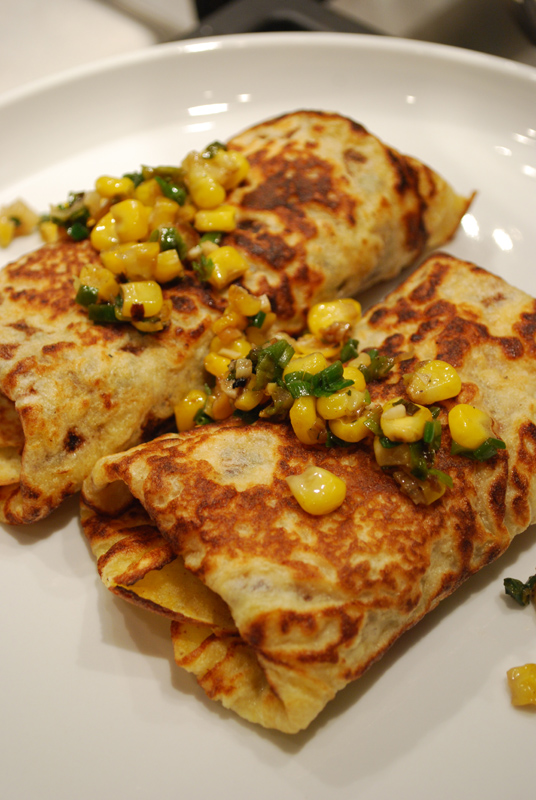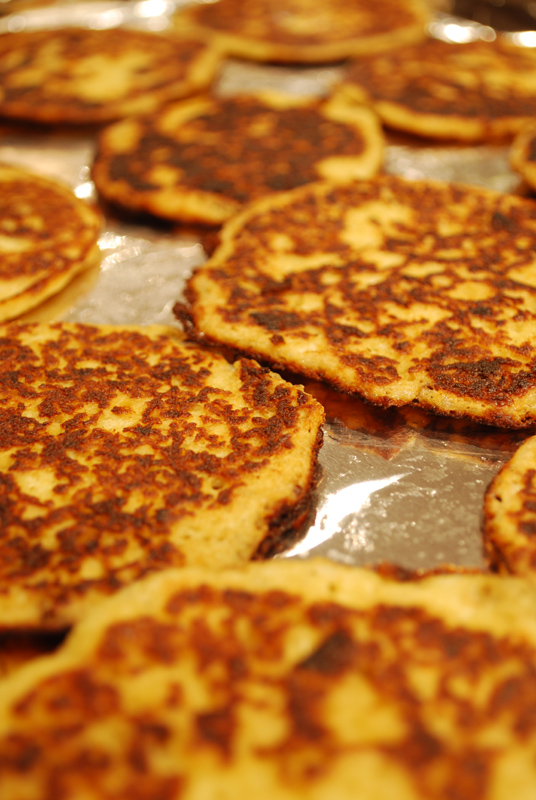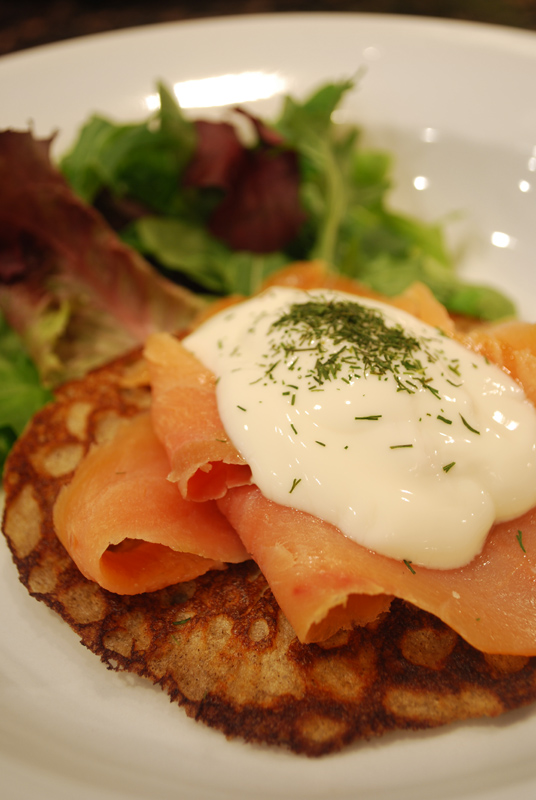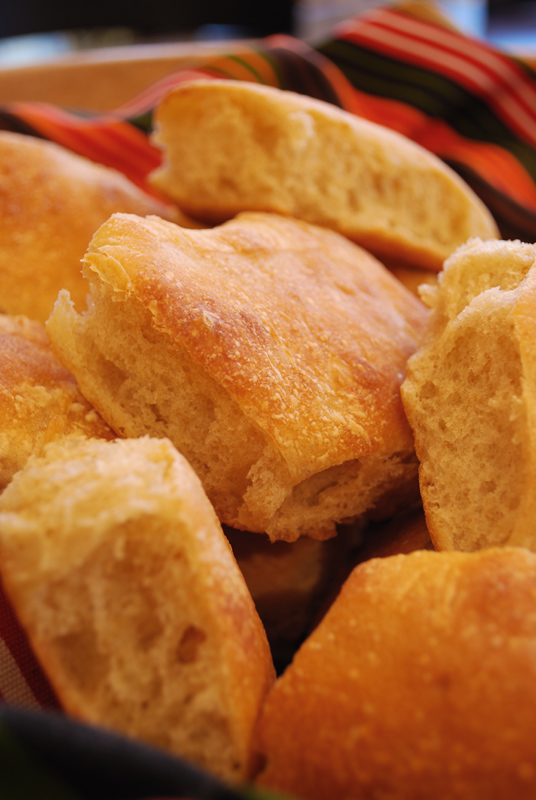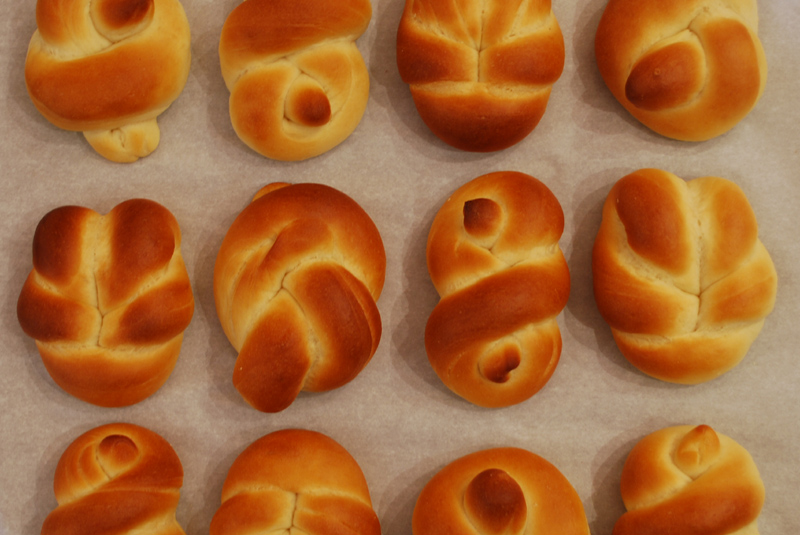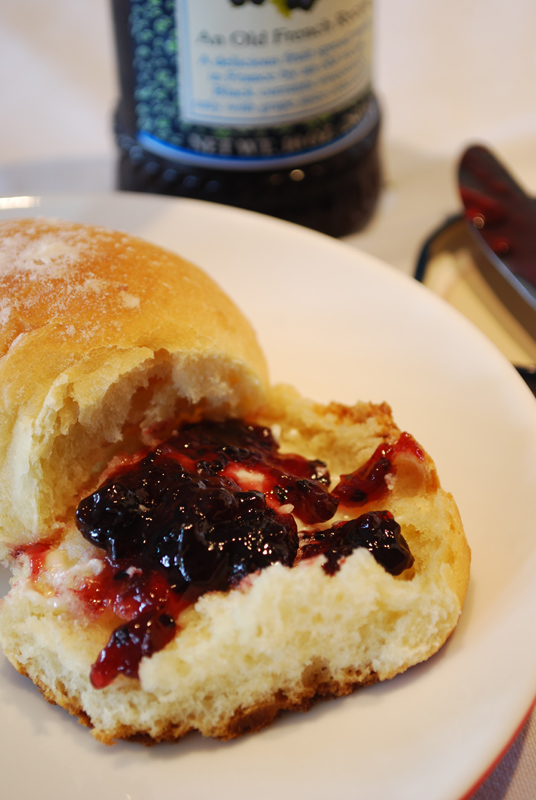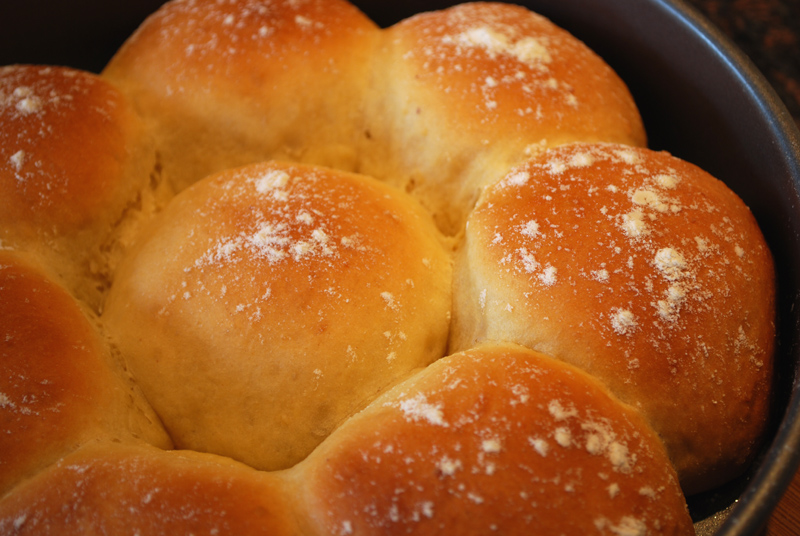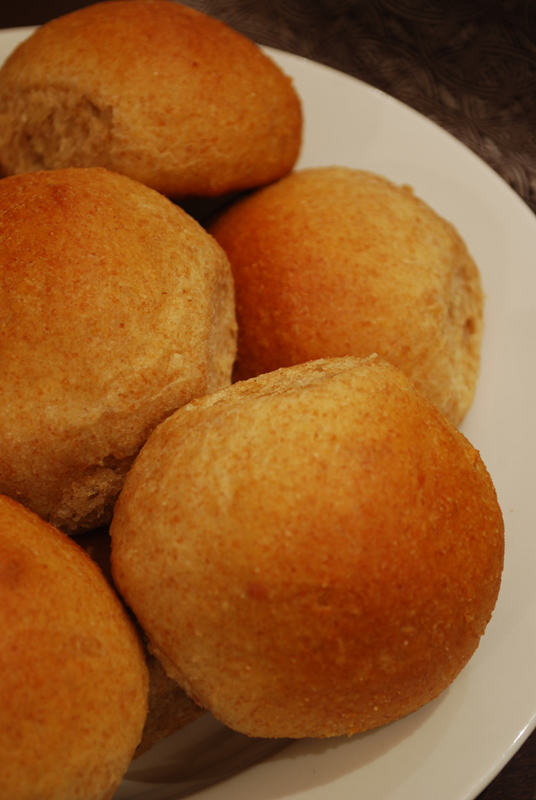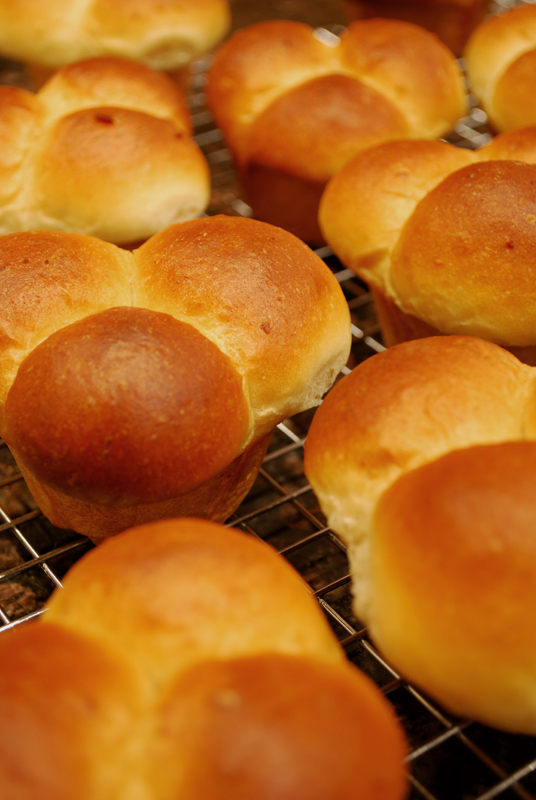Week Ten: Dinner Rolls
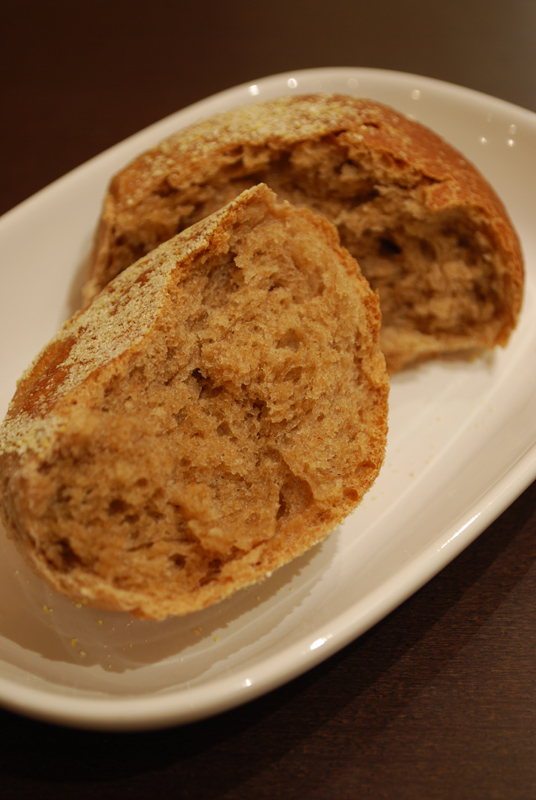
All right, y’all. I think it’s high time we had the talk. You know, the birds and the bees, and all that. I’m talking about the one living (as in actually alive) part of your bread, the thing that makes so many of you run screaming into the cold night, that’s right, I’m talking about yeast. (dum dum dummmm!)
Many people I know, who otherwise are daring enough cooks to make their own pasta, or gamely tackle a whole roast pheasant, are scared silly by yeast.* And believe me, I understand the fear. Have you seen the selection of yeast out there? It’s staggering! There’s Instant, Quick-Rise, Active-Dry, Fast-Acting, Rapid-Rise, yeast for Bread Machines, and fresh yeast, though I probably missed a few. What does it all mean? And then you have to be careful about temperatures? It’s too much!
Lucky for us, though, there are really only two basic types of yeast for the home cook: active-dry and instant. (Fresh compressed yeast is rather difficult to find, and rarely used by home cooks, so I’ll skip it.) Any other sort of labeling is really just marketing. What’s the difference?
Well, where fresh compressed yeast contains about 70% moisture, active-dry contains only 5% moisture. This means that the yeast cells are essentially dormant until they get rehydrated. Note I said “essentially”; they will eventually die without food, hence the expiration date. Yes, you have to pay attention to that. It’s literal this time. Active-dry yeast needs to be rehydrated in warm water, not hot and not cold. Generally, you want it about 110º F, but as long as it’s lukewarm to the touch, it should be okay. Hot water will kill the poor little cells, and cold water will make the cell walls rupture (and therefore kills them). Technically, you don’t have to proof the yeast (that step where you mix it with some water, and wait for it to get foamy), but I always like that extra reassurance that I’m doing it right.
Instant yeast (or quick-rise, rapid-rise, bread machine yeast, or any other similarly-named product; it’s basically all the same thing) has slightly less moisture than active-dry, but is specially developed to have porous cells that absorb water instantly. This means that you can mix it directly into the dry ingredients; and, for some very technical reasons that I’m not getting into right now, the water can (and should ideally) be hotter, up to around 130º F. Now, this so-called “rapid rise” yeast doesn’t actually make your bread rise any faster. It does, however, give off more gas than any other kind of yeast, so you need less of it to get the same rising. And since both instant and active-dry yeast is packaged in the same little 1/4 ounce foil packets, you’re actually using more yeast than you need if you use the full amount of instant.
So now you know the difference between all those types of yeast, and one level of confusion has been swept away. Now what about temperature? Ok, it can be a little worrisome, but it’s really not that tricky! If you have a thermometer (properly calibrated, of course!), all the guesswork is eliminated. If you don’t, though, a good rule of thumb is to drip a little of the warm water onto the inside of your wrist. If it feels about skin temperature, then it’s just fine. If it feels a little warm, that’s fine too; but if it feels hot, then you need to let it cool down, or start again. That’s all there is to it!
If your liquid is on the cool side, it may take a little longer to rise, and vice versa for warmer temperatures. But rise it will, since yeast will continue to multiply and grow for practically forever, as long as there’s still food for them. This means that even a small pinch of yeast will leaven many loaves of bread, given enough time. Surely you’re familiar with that No-Knead Bread recipe that’s been all the buzz? There’s very little yeast in there, but because of the very long rising time, it’s just the right amount. So the more yeast you use, the faster the bread rises. Unfortunately, you don’t get the best flavor that way. That’s why the best-tasting breads often need a day or more to make.
So what exactly does yeast do in bread? Yeast cells eat sugar (long story short, it comes from the carbohydrates in the flour) and convert it to carbon dioxide (gas to make your bread rise) and alcohol (improves flavor and texture). The gluten you worked so hard to make holds the carbon dioxide in, and creates little pockets of air. If you let the dough rise too long, the gas stretches the gluten, which eventually breaks like a rubber band stretched too far, and the texture of the bread is affected for the worse. If you don’t let it rise enough, there isn’t enough air, and your bread turns out too dense.
Generally speaking, 1/2 ounce of fresh yeast (about one of those foil packets of active-dry or instant) will leaven between 5 and 6 cups of flour in about 1 to 2 hours at room temperature. Why so inexact? Well, we’re dealing with living things here. Many variables will affect your little yeasts: air temperature, humidity, dough temperature, elevation, how much food they’re getting, what sort of flour you use, etc. etc. etc. But don’t let that scare you off; it’s kind of exciting! Just think, no matter how many times you make a bread, it’ll turn out a little different every time. That’s so neat!
Now, if yeast is a living thing, does that mean that vegans can’t eat it? Technically speaking, I’d have to say yes; but I think that’s a question you have to answer in your own heart. I am not vegan. I have no such quandaries.
This recipe below uses instant yeast, but you can use whatever kind you’ve got on hand. Just make sure to convert the measurements! This bread is like the one that’s served at a certain Australian-themed chain steakhouse. I’ll leave you to figure out which one. It makes me a little ashamed to admit it, but this bread is absolutely delicious. I think there’s a special place in hell for the man who invented the typical American Chain Restaurant, you see; but every so often, they do come up with something you just can’t help but love. I figure it’s much better to avoid the appalling and certain hour-long wait, avoid all the oversized and overpriced plates, and bake the bread yourself in the comfort of your own home. It’s cheaper, you know what’s in the bread, and it tastes just right.
Oh, and by the way, here’s a general conversion for you:
2 tsp (.22 oz) fresh yeast = 1 tsp (.11 oz) active-dry yeast = 3/4 tsp (.08 oz) instant yeast
Or here is an excellent conversion table that I’ve used before.
Dark “Steakhouse” Rolls
Makes 10 rolls
1 1/3 cups warm water
4 tablespoons butter, softened
1/4 cup honey
1/4 cup molasses
2 3/4 cups (about 12 1/2 ounces) unbleached bread flour
1 3/4 cups (about 7 3/4 ounces) whole-wheat flour
2 teaspoons salt
1 tablespoon unsweetened cocoa powder
2 1/2 teaspoons instant yeast
Yellow cornmeal, for sprinkling on rolls
1. Combine all of the dough ingredients in the bowl of an electric mixer. Mix until you’ve formed a smooth, slightly sticky dough.
2. Let the dough rise in the mixer bowl, covered with plastic wrap, for 1 hour. It won’t have doubled in size, but should be just a bit puffy.
3. Divide the dough into 10 even pieces (about 4 ounces each), and shape the pieces into oval rolls. Coat each roll, top and bottom, with some yellow cornmeal. Place them on a lightly greased or parchment-lined baking sheet, and allow them to rise, covered, in a warm place, for 90 minutes to 2 hours. They won’t have doubled in size, but will appear puffy; when you gently press your finger into the side, the indentation will rebound quite slowly.
4. Bake the rolls in a preheated 350°F oven for 24 minutes, until the bottoms appear slightly browned (you’ll have to carefully pick one up to look), or until an instant-read thermometer inserted into the center of a roll reads about 200°F. Remove the rolls from the oven, and cool them on a rack.
* – May not actually be scared completely silly.

